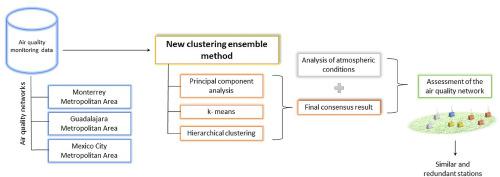Atmospheric Pollution Research ( IF 4.5 ) Pub Date : 2020-05-04 , DOI: 10.1016/j.apr.2020.05.005 Tobias Stolz , María E. Huertas , Alberto Mendoza

|
The spatial representativeness of air quality stations is a crucial factor in monitoring networks for designing and applying adequate air quality control measures. If redundant stations, which duplicate air quality data, want to be avoided in order to optimize and reduce the operational cost of air quality networks, robust methodologies must be applied for identifying redundant stations. Therefore, this study proposes the use of a clustering ensemble method to recognize similar and redundant stations by combining three clustering techniques: principle component analysis, hierarchical clustering, and k-means. The result of the ensemble method is analyzed based on additional information, such as emission sources and the meteorological and topographical conditions of the area of interest. This methodology is applied to the ozone (O3) and particulate matter with an aerodynamic diameter of less than or equal to 10 μm (PM10) time series data, acquired from the air pollutant monitoring systems located in the three main metropolitan areas of Mexico: Mexico City (MCMA), Monterrey (MMA), and Guadalajara (GMA). The findings show that the GMA has a well distributed air quality network with the fewest number of similar stations, as well as the MMA, which presents the same stations clusters for PM10 and O3. In contrast, in the MCMA, a cluster of possible redundant stations is found. Results confirm that the clustering ensemble method represents a reliable tool for identifying similar stations.
中文翻译:

使用集成聚类法评估墨西哥三个主要都会区的空气质量监测网络
空气质量站的空间代表性是监测网络中设计和应用适当的空气质量控制措施的关键因素。如果要避免重复空气质量数据的冗余站点,以优化并降低空气质量网络的运营成本,则必须采用可靠的方法来识别冗余站点。因此,本研究建议通过结合三种聚类技术:主成分分析,层次聚类和k均值,使用聚类集成方法识别相似和冗余的站点。综合方法的结果是根据其他信息进行分析的,例如排放源以及感兴趣区域的气象和地形条件。该方法适用于臭氧(O3)和空气动力学直径小于或等于10μm(PM 10)时间序列数据的颗粒物,这些数据是从位于墨西哥三个主要都会区的空气污染物监测系统获取的:墨西哥城(MCMA),蒙特雷( MMA)和瓜达拉哈拉(GMA)。研究结果表明,GMA和MMA的空气质量网络分布良好,而类似站点的数量最少,而MMA则为PM 10和O 3提供了相同的站点集群。相反,在MCMA中,找到了可能的冗余站集群。结果证实,聚类集成方法是识别相似站点的可靠工具。



























 京公网安备 11010802027423号
京公网安备 11010802027423号